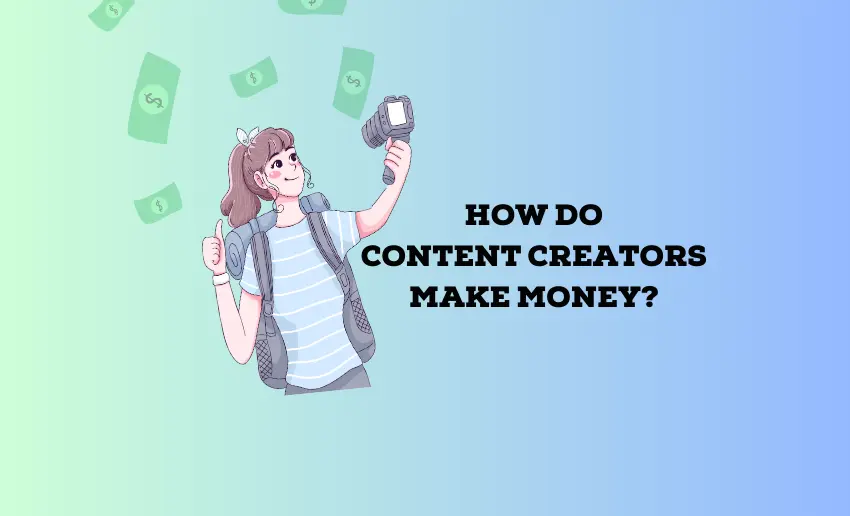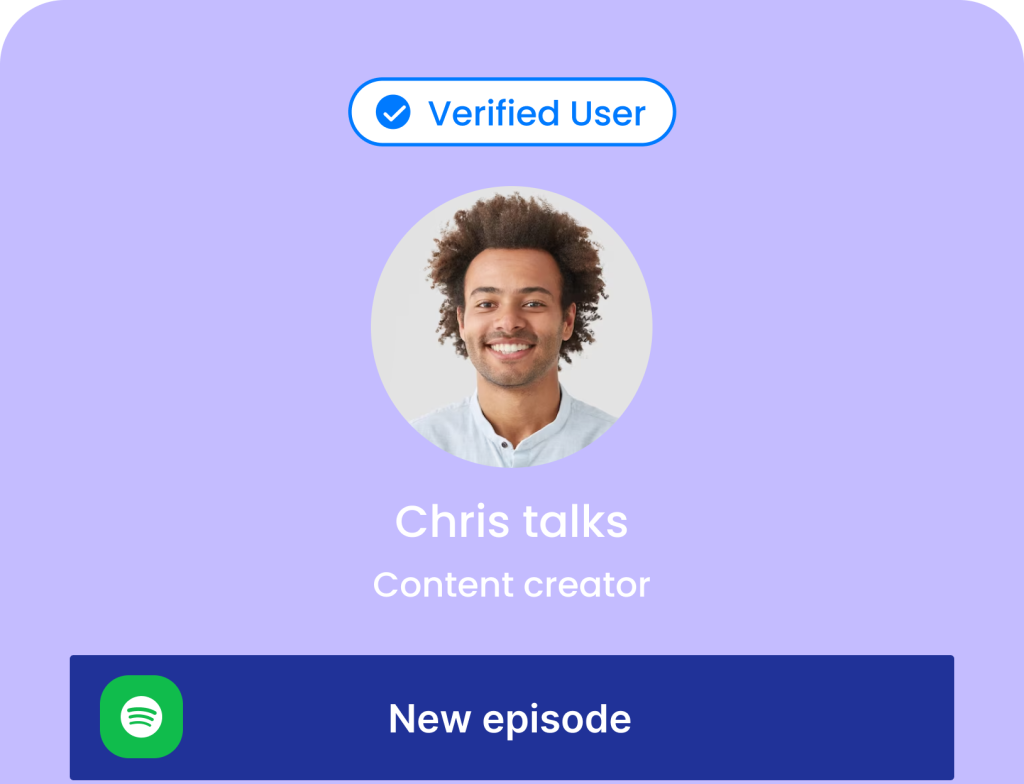Have you ever wondered how your favorite Influencers, YouTubers, bloggers, or podcasters turn their passion into a paycheck? Content creators have mastered making money through various avenues beyond simple views or likes. Many have even unlocked multiple streams of income that fuel their passion and sustain their craft. This article unveils the ways content creators earn money, diving into the diverse strategies and methods they use to monetize their content.
How do content creators make money?
For most content creators, making money is the ultimate goal. To this end, they employ diverse monetization techniques to get paid. Below are a few of the most popular means for content creators to earn money:
1. Ad Revenue through platforms
Content creators earn money by displaying ads on their content. Platforms like YouTube or blogs enable this by sharing ad revenue. The more views or clicks the ads get, the more money creators make. It’s like renting space on your ad content, and the platform pays you for the exposure. Creators need a sizable audience to earn significantly from this method, as ad revenue can vary based on views and engagement.
2. Sponsorships and brand deals
Creators collaborate with brands to promote their products or services. Brands pay creators to showcase their offerings to the creator’s audience. It’s a form of endorsement where creators align with brands that resonate with their content. These deals can include dedicated videos, social media posts, or mentions. Successful partnerships depend on trust between the creator and their audience, ensuring authenticity in the promotion.
3. Affiliate marketing
Through affiliate marketing, creators promote products or services and earn a commission for each sale through their unique referral link. They share these links in their content, recommending products they genuinely like or believe in. It’s like being a salesperson who gets rewarded for directing customers to a particular store. Authenticity and trust play a crucial role here, as audiences value honest recommendations from creators.
4. Selling merchandise
Many content creators develop branded merchandise, such as clothing, accessories, or digital products like ebooks or online courses. They promote these items to their audience, often leveraging their brand and loyal following. Selling merchandise allows creators to diversify their income streams while offering fans a tangible way to support their favorite content creators.
5. Crowdfunding and donations
Some creators rely on the support of their audience through crowdfunding platforms like Patreon and Ko-fi or even direct donations via platforms like PayPal or Venmo. They offer exclusive content, perks, or early access in return for financial support. It’s like fans contributing to help their favorite creator continue making content they love. This method fosters a closer relationship between creators and their most dedicated supporters.
6. Subscription services
Platforms like Twitch or YouTube offer subscription-based models where viewers can support creators through monthly subscriptions. In return, subscribers often receive perks like exclusive content, badges, or ad-free viewing experiences. This creates a more stable income for creators than ad revenue based on a subscription model.
7. Licensing content
Creators can license their content, such as photographs, videos, or music, for use by other individuals or companies. They earn royalties or a one-time payment whenever their content is used. Licensing content allows creators to monetize their work beyond their primary audience, potentially generating passive income over time.
8. Speaking engagements and workshops
Established content creators often leverage their expertise to conduct workshops, seminars, or speaking engagements. They may be invited to events or conferences to share their knowledge and experiences. They earn money through speaker fees, ticket sales for their workshops, or consulting services, capitalizing on their expertise beyond their online presence.
9. Writing books or eBooks
Some content creators venture into writing books or ebooks based on their expertise or experiences. They earn royalties from book sales or downloads. This allows them to reach a wider audience beyond their online following and establish themselves as authoritative figures in their respective fields.
10. Coaching and consulting services
Creators with specialized skills or knowledge offer coaching or consulting services. They assist individuals or businesses based on their expertise, charging fees for personalized guidance. It’s like offering one-on-one tutoring or professional advice, leveraging their expertise to provide value beyond their content.
11. Event hosting and meetups
Content creators sometimes host events, meetups, or workshops for their audience. They may charge admission fees or partner with sponsors to cover expenses and generate income. These events allow creators to connect with their audience in person while monetizing through ticket sales or sponsorships.
12. Creating online courses
Utilizing their expertise, content creators develop and sell online courses or workshops. These courses cover various topics, providing valuable knowledge to their audience. Creators earn money through course sales, often offering comprehensive learning experiences beyond what’s available in their free content.
13. Product collaborations and endorsements
Apart from sponsorships, creators collaborate with companies to co-create products. They might design a limited-edition item, develop an app, or contribute to product development. In exchange, they receive payment or a share of the product’s profits.
14. Freelance Work
Some content creators offer freelance services related to their niche. For instance, a photography YouTuber might offer freelance photography services. They use their platform to advertise their skills and expertise, attracting clients and earning income beyond their content creation.
15. Grants and Awards
Certain content creators qualify for grants, scholarships, or awards based on their work. These can come from organizations, institutions, or contests in their field. Winning or receiving these grants provides creators with financial support and recognition for their contributions to their industry or community.
How do content creators get paid?
Depending on their chosen monetization strategies, content creators get paid through various channels and methods. Payment can be in various forms: direct deposits, checks, PayPal, wire transfers, or platform-specific payment systems (like YouTube’s AdSense or Patreon’s payouts). In addition to this, payment frequency varies based on the monetization method and platform policies (monthly, bi-monthly, etc.).
How do I determine the best monetization technique for me?
Finding the best monetization technique for you involves considering various factors to align with your content, audience, and goals. Here’s a step-by-step guide to help:
1. Know your audience
Understand your audience’s preferences, behaviors, and needs. Analyze their demographics, interests, and engagement patterns. Tailor your monetization strategy to what resonates with them.
2. Evaluate your content type
Different content types suit specific monetization methods. For instance, video content might perform well with ad revenue or sponsorships, while educational content could drive digital product sales or memberships.
3. Assess your content quality
High-quality, valuable content builds trust and a loyal following. Monetization methods that align with your content quality tend to yield better results. Determine which methods complement your content’s strengths.
4. Analyze competitor strategies
Research what successful creators in your niche are doing. Analyze their monetization techniques and assess how they fit with their content and audience. Adapt these insights to your unique approach.
5. Set clear goals
Define your short-term and long-term goals. Are you looking for immediate revenue, long-term sustainability, or audience growth? Your goals will influence which monetization methods align best.
6. Consider diversification
Explore multiple revenue streams rather than relying solely on one method. Diversification minimizes risks and maximizes overall earnings. Find a balance that suits your content and audience.
7. Personal preferences and expertise
Consider your strengths, interests, and skills. Are you more comfortable with certain methods like affiliate marketing, selling products, or offering services? Leverage what you excel at. You’ll also have to consider the resources (time, money, manpower) required for each monetization method. Some techniques might demand more effort or investment than others.
8. Solicit audience feedback
Engage with your audience and gather feedback. Conduct surveys, polls, or direct discussions to understand their willingness to use specific monetization methods.
Can I combine multiple monetization techniques?
Content creators can combine multiple monetization techniques. This is often a smart strategy for content creators. Diversifying your income streams maximizes earnings and creates a more stable and resilient revenue model.
While combining monetization techniques sounds great and rewarding, it can be a slippery slope to tread. Content creators must carefully determine which monetization technique complements each other without sacrificing audience experience. Here’s how you can effectively combine different monetization techniques:
1. Layer monetization methods
Utilize multiple methods simultaneously without overwhelming your audience. For example, combine ad revenue with affiliate marketing or sponsorships with selling digital products.
2. Tailor to different platforms
Different platforms offer various monetization options. Adapt your strategy based on the platform’s capabilities. For instance, on YouTube, you might use ad revenue and memberships; on a blog, you might focus on affiliate marketing and selling products.
3. Create synergy among methods
Make your monetization methods complement each other. For instance, use sponsorships that align with the products you sell or create exclusive content for your subscribers that ties into your affiliate marketing strategy.
4. Prioritize audience experience
Ensure that combining multiple methods doesn’t negatively impact the audience experience. Maintain a balance between monetization and providing value to your audience.
5. Timing and consistency
Introduce new monetization methods gradually and consistently. Abrupt changes might disrupt audience engagement. Communicate changes transparently to your audience.
6. Monitor performance
Regularly track and analyze the performance of each monetization method. Adjust or drop techniques that underperform while strengthening those that resonate well with your audience.
5 Challenges faced by content creators
Like any other endeavor, content creators face multiple challenges before getting paid significantly. Understanding these challenges beforehand can give you a sense of how to navigate through each one when you experience them:
1. Audience growth and engagement
Building a sizable and engaged audience remains a common challenge for content creators. It takes time and consistent effort to attract and retain viewers or followers. Keeping the audience engaged with fresh, valuable content is crucial. Understanding audience preferences, responding to comments, and fostering a community help overcome this challenge. Consistency and quality content creation are pivotal in sustaining audience growth and interaction.
2. Monetization stability
Achieving consistent and stable income streams can be challenging. Fluctuations in ad revenue, algorithm changes affecting reach, or varying sales cycles impact income stability. Diversifying revenue streams, balancing short-term gains with long-term strategies, and adapting to market trends help mitigate this challenge. Successful creators often rely on multiple monetization methods to offset fluctuations and ensure financial stability.
3. Content creation burnout
Content creators often face burnout due to the demands of consistent content production. Generating creative ideas, maintaining quality, and meeting deadlines can be overwhelming. Strategies to combat burnout include:
- Creating a content schedule.
- Taking breaks.
- Delegating tasks where possible.
- Seeking inspiration from diverse sources.
Prioritizing self-care and mental health is crucial to sustain creativity and avoid burnout.
4. Evolving platforms and algorithms
Navigating constant changes in platform algorithms and policies poses a challenge. These changes can affect visibility, reach, and monetization potential. Staying updated on platform updates, adapting content strategies, and diversifying across multiple platforms can mitigate the impact of sudden algorithm changes. Flexibility and a willingness to adapt are key to thriving amid evolving digital landscapes.
5. Competition and differentiation
Standing out in a crowded content landscape amidst intense competition remains a significant challenge. Finding a unique voice, niche, or angle that sets content apart. Consistently delivering high-quality, original content, engaging with the audience authentically, and offering something distinctive helps creators differentiate themselves. Building a personal brand and establishing a unique value proposition is essential to cut through the competition.
In the End
Content creators have many revenue streams, from ad revenue and sponsorships to affiliate marketing. However, diversifying income sources is a smart strategy, providing stability and potential for growth. Exploring these varied avenues allows creators to find what works best for their content, audience, and long-term goals.








